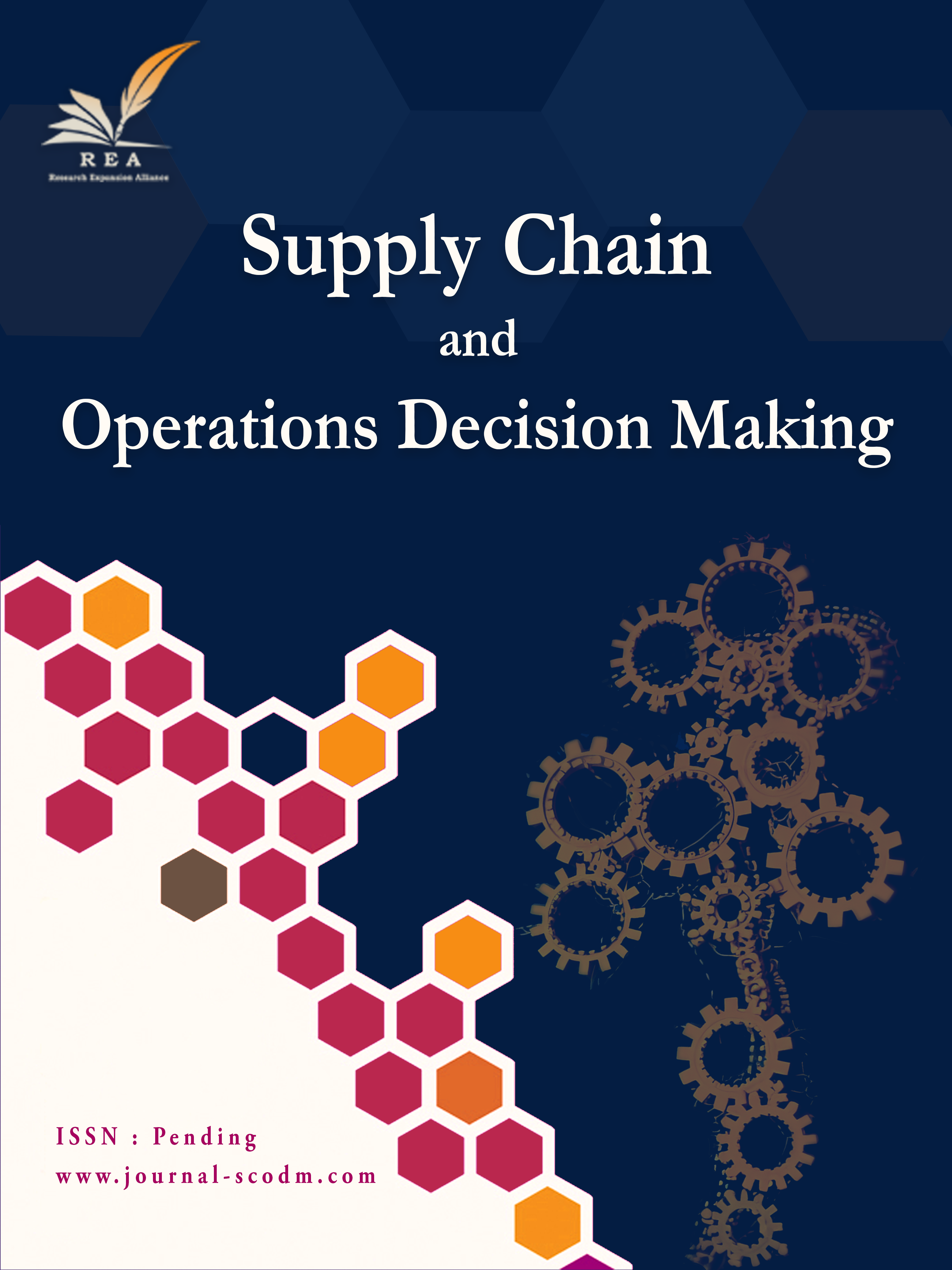A Short Review of EOQ Models and Fuzzy Theory in Inventory Management
Abstract
In our manuscript, we investigate diverse approaches and methodologies proposed by researchers and scientists. Our analysis encompasses supply chain management, vendor management, and healthcare systems. Specifically, we delve into Economic Order Quantity (EOQ) within IM, exploring its implications. Additionally, we aim to present literature on fuzzy theory, including discussions about triangular and trapezoidal fuzzy sets. Recognizing that classical theory grapples with uncertainty, we underscore the significance of comprehending fuzzy theory through relevant scholarly works.
Keywords:
EOQ, SCM, IMReferences
- [1] K, S. J. (2006). Operations research: theory and applications. MACMILAN Publishers.
- [2] Hussein, H. A., Shiker, M. A. K., & Zabiba, M. S. M. (2020). A new revised efficient of vam to find the initial solution for the transportation problem. Journal of physics: conference series (p. 12032). IOP Publishing. https://doi.org/10.1088/1742-6596/1591/1/012032
- [3] Singh, A., Wiktorsson, M., & Hauge, J. B. (2021). Trends in machine learning to solve problems in logistics. Procedia cirp, 103, 67–72. https://doi.org/10.1016/j.procir.2021.10.010
- [4] Dubey, A., & Kumar, R. (2023). Extended uncertainty principle for inventory control: an updated review of environments and applications. International journal of neutrosophic science, 21(4), 8–20. https://doi.org/10.54216/IJNS.210401
- [5] Tripathi, S. K., & Kumar, R. (2023). A review of neutrosophic linear programming problems under uncertain environments. International journal of neutrosophic science, 21(4), 94–105. https://doi.org/10.54216/IJNS.210410
- [6] Navya Pratyusha, M., & Kumar, R. (2023). Critical path method and project evaluation and review technique under uncertainty:a state-of-art review. International journal of neutrosophic science, 21(3), 143–153. https://doi.org/10.54216/IJNS.210314
- [7] Dubey, A., & Kumar, R. (2024). Recent trends and advancements in inventory management. EAI endorsed transactions on scalable information systems, 11(2), 1–5. https://doi.org/10.4108/eetsis.4543
- [8] Tripathi, S. K., & Kumar, R. (2023). A short literature on linear programming problem. EAI endorsed transactions on energy web, 10(1), 1–5. https://doi.org/10.4108/ew.4516
- [9] Tripathi, S. K., Dey, A., Broumi, S., & Kumar, R. (2024). Exploring neutrosophic linear programming in advanced fuzzy contexts. Neutrosophic sets and systems, 66, 170–184. https://doi.org/10.5281/zenodo.10939251
- [10] Pratyusha, N. M., Dey, A., Broumi, S., & Kumar, R. (2024). Critical Path method and project evaluation and review technique: a neutrosophic review. Neutrosophic sets and systems, 67, 135–146. https://doi.org/10.5281/zenodo.11123614
- [11] Pratyusha, M. N., & Kumar, R. (2024). Enhancing critical path problemin neutrosophic environment using Python. CMES - computer modeling in engineering and sciences, 140(3), 2957–2976. https://doi.org/10.32604/cmes.2024.051581
- [12] Dubey, A., & Kumar, R. (2024). Inventory model with sensitivity analysis under uncertain environment. Journal of information and optimization sciences, 45(4), 1081–1092. https://doi.org/10.47974/jios-1693
- [13] Pratyusha, M. N., & Kumar, R. (2024). Solving neutrosophic critical path problem using Python. Journal of information and optimization sciences, 45(4), 897–911. https://doi.org/10.47974/JIOS-1614
- [14] Tripathi, S., & Kumar, R. (2024). Solving neutrosophic minimal cost flow problem using multi-objective linear programming problem. Journal of information and optimization sciences, 45, 1093–1104. https://doi.org/10.47974/JIOS-1694
- [15] Edalatpanah, S. A. (2018). Neutrosophic perspective on DEA. Journal of applied research on industrial engineering, 5(4), 339–345. https://doi.org/10.22105/jarie.2019.196020.1100
- [16] Edalatpanah, S. A. (2019). A nonlinear approach for neutrosophic linear programming. Journal of applied research on industrial engineering, 6(4), 367–373. https://doi.org/10.22105/JARIE.2020.217904.1137
- [17] Salimi, P. S., & Edalatpanah, S. A. (2020). Supplier selection using fuzzy AHP method and D-numbers. Journal of fuzzy extension and applications, 1(1), 1–14. https://doi.org/10.22105/jfea.2020.248437.1007
- [18] Edalatpanah, S. A. (2023). A paradigm shift in linear programming: an algorithm without artificial variables. Systemic analytics, 1(1), 1–10. https://doi.org/10.31181/sa1120232
- [19] Sallam, K., Mohamed, M., & Wagdy Mohamed, A. (2023). Internet of things (IoT) in supply chain management: challenges, opportunities, and best practices. Sustainable machine intelligence journal, 2, 1–3. https://doi.org/10.61185/smij.2023.22103
- [20] Khalifa, H. A. E.-W., Edalatpanah, S. A., & Bozanic, D. (2024). On min-max goal programming approach for solving piecewise quadratic fuzzy multi- objective de novo programming problems. Systemic analytics, 2(1), 36–48. https://doi.org/10.31181/sa21202411
- [21] Zahedi, M., Naghdi Khanachah, S., & Zahedi, M. (2024). Providing a structural model lean sustainable supply chain with total quality management approech in the automotive industry. International journal of research in industrial engineering, 13(2), 152–165. https://doi.org/10.22105/riej.2022.342951.1312
- [22] Nazabadi, M. R., Najafi, E., & Rasinojehdehi, R. (2024). Integrated decision-making in production, maintenance, repair, and quality planning using an agent-based simulation. Risk assessment and management decisions, 1(1), 12–21. https://ramd.reapress.com/journal/article/view/23
- [23] Saeedi, S., Mohammadi, M., & Torabi, S. A. (2015). A de novo programming approach for a robust closed-loop supply chain network design under uncertainty: An M/M/1 queueing model. International journal of industrial engineering computations, 6(2), 211–228. https://doi.org/10.5267/j.ijiec.2014.11.002
- [24] Harris, F. W. (1990). How many parts to make at once. Operations research, 38(6), 947–950.
- [25] Rabbani, M., Rezaei, H., Lashgari, M., & Farrokhi-Asl, H. (2018). Vendor managed inventory control system for deteriorating items using metaheuristic algorithms. Decision science letters, 7(1), 25–38. https://doi.org/10.5267/j.dsl.2017.4.006
- [26] Saha, E., & Ray, P. K. (2019). Modelling and analysis of healthcare inventory management systems. Opsearch, 56(4), 1179–1198. https://doi.org/10.1007/s12597-019-00415-x
- [27] Jiang, Y., Shi, C., & Shen, S. (2019). Service level constrained inventory systems. Production and operations management, 28(9), 2365–2389. https://doi.org/10.1111/poms.13060
- [28] Yadav, A. S., Ahlawat, N., Sharma, N., Swami, A., & Navyata. (2020). Healthcare systems of inventory control for blood bank storage with reliability applications using genetic algorithm. Advances in mathematics: scientific journal, 9(7), 5133–5142. https://doi.org/10.37418/amsj.9.7.80
- [29] Abdolazimi, O., Shishebori, D., Goodarzian, F., Ghasemi, P., & Appolloni, A. (2021). Designing a new mathematical model based on ABC analysis for inventory control problem: A real case study. RAIRO - operations research, 55(4), 2309–2335. https://doi.org/10.1051/ro/2021104
- [30] Fikri, A., Andika, A., Dava Cahyoga, M. A., & Ratnasari, A. (2020). Implementation of the FIFO Method in the development of inventory applications for agents sinar baru. Journal of information systems and informatics, 2(2), 216–230. https://doi.org/10.33557/journalisi.v2i2.72
- [31] Ajay, S. Y., Abid, M., Bansal, S., Tyagi, S. L., & Kumar, T. (2020). Fifo and lifo in green supply chain inventory model of hazardous substance components industry with storage using simulated annealing. Advances in mathematics: scientific journal, 9(7), 5127–5132. https://doi.org/10.37418/amsj.9.7.79
- [32] Zhu, S., Jaarsveld, W. van, & Dekker, R. (2020). Spare parts inventory control based on maintenance planning. Reliability engineering and system safety, 193, 106600. https://doi.org/10.1016/j.ress.2019.106600
- [33] Rashid Hashmi, A., Aina Amirah, N., Yusof, Y., & Noor Zaliha, T. (2020). Exploring the dimensions using exploratory factor analysis of disruptive factors and inventory control. The economics and finance letters, 7(2), 247–254. https://doi.org/10.18488/journal.29.2020.72.247.254
- [34] Ahmed, E. R., Alabdullah, T. T. Y., Ardhani, L., & Putri, E. (2021). The Inventory control system’s weaknesses based on the accounting postgraduate students’ perspectives. Jabe (journal of accounting and business education), 5(2), 2528–7281. https://doi.org/10.26675/jabe.v5i2.19312
- [35] Hashmi, A. R., Amirah, N. A., Yusof, Y., & Zaliha, T. N. (2021). Mediation of inventory control practices in proficiency and organizational performance: state-funded hospital perspective. Uncertain supply chain management, 9(1), 89–98. https://doi.org/10.5267/j.uscm.2020.11.006
- [36] Bhalla, S., Alfnes, E., Hvolby, H. H., & Sgarbossa, F. (2021). Advances in spare parts classification and forecasting for inventory control: A literature review. IFAC-papersonline, 54(1), 982–987. https://doi.org/10.1016/j.ifacol.2021.08.118
- [37] Song, J.-S. J., Xue, Z., & Shen, X. (2021). Demand management and inventory control for substitutable products. SSRN electronic journal, 12, 1–44. https://doi.org/10.2139/ssrn.3866775
- [38] Boute, R. N., Gijsbrechts, J., van Jaarsveld, W., & Vanvuchelen, N. (2022). Deep reinforcement learning for inventory control: A roadmap. European journal of operational research, 298(2), 401–412. https://doi.org/10.1016/j.ejor.2021.07.016
- [39] Mittal, S. (2024). Framework for optimized sales and inventory control: a comprehensive approach for intelligent order management application. International journal of computer trends and technology, 72(3), 61–65. https://doi.org/10.14445/22312803/ijctt-v72i3p109
- [40] Mandal, D. B. (2020). An inventory model for time-varying deteriorating items and weibull distributed ameliorating items with cubic demand under salvage value and shortages. International journal for research in applied science and engineering technology, 8(11), 307–315. https://doi.org/10.22214/ijraset.2020.32126
- [41] Samal, D., Mishra, M. R., & Kalam, A. (2022). An EOQ model for Inventory System dependent upon on hand inventory without shortages. Journal of integrated science and technology, 10(3), 193–197.
- [42] Çalışkan, C. (2022). Derivation of the optimal solution for the economic production quantity model with planned shortages without derivatives. Modelling, 3(1), 54–69. https://doi.org/10.3390/modelling3010004
- [43] Patriarca, R., Di Gravio, G., Costantino, F., & Tronci, M. (2020). EOQ inventory model for perishable products under uncertainty. Production engineering, 14(5–6), 601–612. https://doi.org/10.1007/s11740-020-00986-5
- [44] Sundararajan, R., Vaithyasubramanian, S., & Nagarajan, A. (2021). Impact of delay in payment, shortage and inflation on an EOQ model with bivariate demand. Journal of management analytics, 8(2), 267–294. https://doi.org/10.1080/23270012.2020.1811165
- [45] Ghai, S., Chauhan, A., & Singh, M. P. (2020). Optimization of the EOQ model with reliability affected demand rate and uncertainty. International journal of management (IJM), 11(7). https://doi.org/10.34218/IJM.11.7.2020.153
- [46] Sundararajan, R., Vaithyasubramanian, S., & Rajinikannan, M. (2022). Price determination of a non-instantaneous deteriorating EOQ model with shortage and inflation under delay in payment. International journal of systems science: operations and logistics, 9(3), 384–404. https://doi.org/10.1080/23302674.2021.1905908


